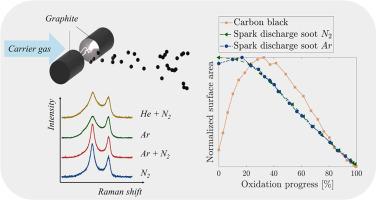Structural evolution during combustion of carbon nanoparticles generated by spark discharge
IF 2.9
3区 环境科学与生态学
Q2 ENGINEERING, CHEMICAL
引用次数: 0
Abstract
The oxidation behaviour of carbon nanoparticles generated by electrical discharge between two graphite electrodes (commonly referred to as spark discharge soot, SDS) is investigated and compared to that of nanoparticles originating from the incomplete combustion of organic fuels. Soot generated via a Combustion Aerosol Standard (CAST) soot generator and carbon black (CB) samples are taken as reference materials for the latter. By changing the carrier gas composition of the spark generator, carbon particles with varying reactivity and nanostructure can be obtained. SDS nanoparticles are considerably smaller, have much higher specific surface areas, and display a distinct nanostructure arrangement compared to CAST soot and CB. The evolution of the surface area with the extent of oxidation is tracked, showing that the surface area development of SDS is fundamentally different from that of CAST soot and CB. While the latter shows an extreme increase in the specific surface area during combustion, in comparison, the specific surface area increase of SDS is marginal. This information is crucial for anticipating the specific surface area gain achievable through partial oxidation, based on the initial morphology of the carbonaceous particles. The reactivity was found to correlate with Raman features. When analysing the evolution of the Raman spectra with oxidation, more reactive SDS showed a substantial increase in nanostructure order compared to the less reactive SDS and CAST soot.

火花放电产生的碳纳米颗粒燃烧过程中的结构演变
研究了两个石墨电极之间放电产生的碳纳米颗粒(通常称为火花放电烟尘,SDS)的氧化行为,并将其与源自有机燃料不完全燃烧的纳米颗粒的氧化行为进行了比较。通过燃烧气溶胶标准(CAST)烟尘发生器产生的烟尘和炭黑(CB)样品作为后者的参考材料。通过改变火花发生器的载气组成,可以得到具有不同反应性和纳米结构的碳颗粒。与CAST烟尘和炭黑相比,SDS纳米颗粒体积更小,比表面积更高,并具有独特的纳米结构排列。跟踪了SDS的表面积随氧化程度的演变,表明SDS的表面积发展与CAST烟灰和CB的表面积发展有着根本的不同。后者在燃烧过程中比表面积急剧增加,相比之下,SDS的比表面积增加是微乎其微的。根据碳质颗粒的初始形态,这一信息对于预测通过部分氧化获得的比表面积增益至关重要。发现反应性与拉曼特征有关。当分析拉曼光谱随氧化的演变时,与活性较低的SDS和CAST烟灰相比,活性较高的SDS显示出纳米结构有序度的显著增加。
本文章由计算机程序翻译,如有差异,请以英文原文为准。
求助全文
约1分钟内获得全文
求助全文
来源期刊

Journal of Aerosol Science
环境科学-工程:化工
CiteScore
8.80
自引率
8.90%
发文量
127
审稿时长
35 days
期刊介绍:
Founded in 1970, the Journal of Aerosol Science considers itself the prime vehicle for the publication of original work as well as reviews related to fundamental and applied aerosol research, as well as aerosol instrumentation. Its content is directed at scientists working in engineering disciplines, as well as physics, chemistry, and environmental sciences.
The editors welcome submissions of papers describing recent experimental, numerical, and theoretical research related to the following topics:
1. Fundamental Aerosol Science.
2. Applied Aerosol Science.
3. Instrumentation & Measurement Methods.
 求助内容:
求助内容: 应助结果提醒方式:
应助结果提醒方式:


